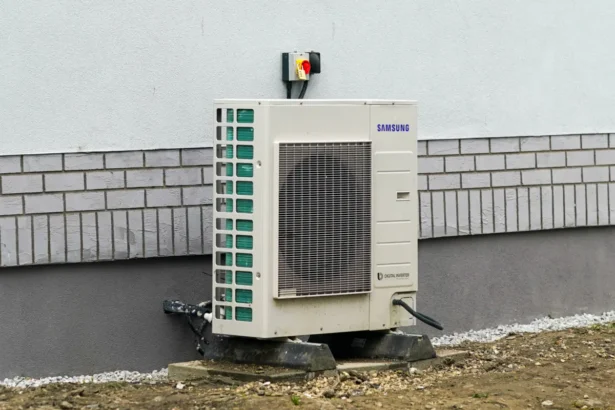President Joe Biden will use emergency wartime powers invoked in the name of “climate change” to boost U.S. production of electric heat pumps as his administration continues its push to replace gas furnaces and other appliances that run on fossil fuels.
President Biden will use the Cold War-era Defense Production Act (DPA) to boost spending on five alternative energy technologies, with electric heat pumps being the first to be awarded money under the emergency authority that is being invoked “on the basis of climate change,” the Department of Energy (DOE) said Friday.
The award involves $169 million for nine projects to accelerate electric heat pump manufacturing at 15 sites across the United States. The money was appropriated under the Inflation Reduction Act, the biggest climate-related bill in United States history.
“Today’s Defense Production Act funds for heat pump manufacturing show that President Biden is treating climate change as the crisis it is,” John Podesta, the president’s senior advisor on clean energy, said in a statement.

The president’s intention to invoke wartime powers to boost domestic production of electric heat pumps and four other technologies (solar, transformers, insulation, and fuel cells) was first announced in June 2022. At the time, the DOE said the rationale for using emergency authority was meant in part to reduce demand for fossil fuels.
“Getting more American-made electric heat pumps on the market will help families and businesses save money with efficient heating and cooling technology,” Secretary of Energy Jennifer Granholm said in a statement.
Ms. Granholm’s department says that heating and cooling homes and buildings, including critical infrastructure like military bases, drive more than 35 percent of U.S. energy consumption. Compared to boilers fueled by natural gas, heat pumps reduce greenhouse gas emissions by up to 50 percent, it says.
Critical Response
The move to bolster electric heat pump production was criticized by the American Gas Association (AGA), a natural gas industry group.
“Energy security is a top priority for AGA. We are deeply disappointed to see the Defense Production Act, which is intended as a vital tool for advancing national security against serious outside threats, being used as an instrument to advance a policy agenda contradictory to our nation’s strong energy position,” AGA president and CEO Karen Harbert said in a statement.
“Increased use of natural gas has been responsible for sixty percent of the electrical grid’s CO2 emissions reductions. This vital tool for emissions reductions and energy system resilience should not be unfairly undermined through misuse of the Defense Production Act,” she added.
Earlier, the DOE proposed new energy efficiency standards for residential water heaters that would require electric water heaters of the most common size to use heat pump technology and gas-fired instantaneous water heaters to use condensing technology to achieve energy efficiency.
At the time, Republicans on the House Subcommittee on Economic Growth, Energy Policy, and Regulatory Affairs argued that the DOE’s proposed appliance efficiency standards would be burdensome and costly for Americans, hitting lower-income families the hardest.
This year, the DOE, along with the Environmental Protection Agency (EPA) and the Department of Transportation (DOT), announced a range of proposed rules that will make household appliances more expensive and, as some experts contend, are designed to force Americans to give up their current appliances.
For example, under the DOE’s proposed natural gas stove rule, an estimated 90 percent of gas stoves would have to be redesigned, with reduced performance, and the upfront cost of stove products would be raised by around $32 million per year.
The list goes on, as enumerated in the DOE’s so-called Unified List of appliances targeted with new energy efficiency standards, with some in the “proposed rule stage” and others in the “final rule stage.”
Biden’s Climate Rules Add $9,100 to Typical US Home
Meanwhile, a consumer watchdog has estimated that the Biden administration’s war on appliances such as gas stoves, in the name of climate change, would cost the average American household over $9,100.
In an infographic titled “Biden’s Dream Home,” the nonprofit Alliance for Consumers puts price tags on the Biden administration’s various proposals for new energy standards for all kinds of appliances found in homes, including air conditioners, washing machines, and gas stoves.
While the list of appliances in the Biden administration’s crosshairs is long—including microwave ovens, ceiling fans, dehumidifiers, and pool pumps—the Alliance for Consumers has picked a selection of what seems to be common equipment found in the average American home, end estimated the cost of the regulatory burden the Biden administration has imposed or is looking to impose on them.
“Welcome to Biden’s Dream House, where the American dream just got significantly more expensive,” the group wrote in a post on X, along with an infographic that reveals some of the price tags.
Welcome to Biden’s Dream House, where the American dream just got significantly more expensive…
Join us on a tour and see the green “upgrades” that the Biden Administration wants to bring (by mandate) to a home near you, very soon.
— Alliance For Consumers (@for_consumers) October 26, 2023
Overall, the estimated cost of Biden administration policies on the typical U.S. family is estimated to be $9,166.
Gas furnace efficiency standards, which the DOE promises will “significantly reduce greenhouse gas emissions” in the residential sector, are estimated to cost consumers an additional $494 on average, according to the consumer watchdog.
Dishwasher efficiency standards, which Secretary of Energy Jennifer Granholm said “will reduce carbon pollution and combat the climate crisis,” will lead to drainage problems and clogging, which the Alliance for Consumers estimates will cost between $50 and $400 to repair.
Proposed rules targeting air conditioning refrigerants would “dramatically” raise prices to refill air conditioning units, the watchdog says, estimating the cost to be roughly $1,100.
New energy standards for water heaters would force families to buy models that the Alliance for Consumers estimates are, on average, $2,800 more expensive.
Other costs include $25 for ceiling fans, $200 for washing machines, and $140 for light bulbs.
From The Epoch Times

